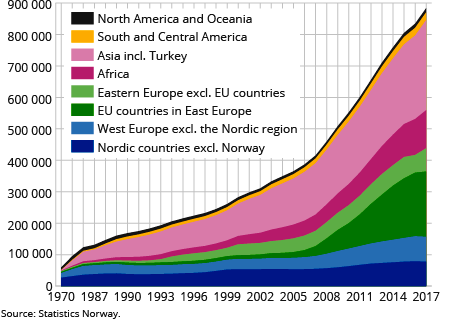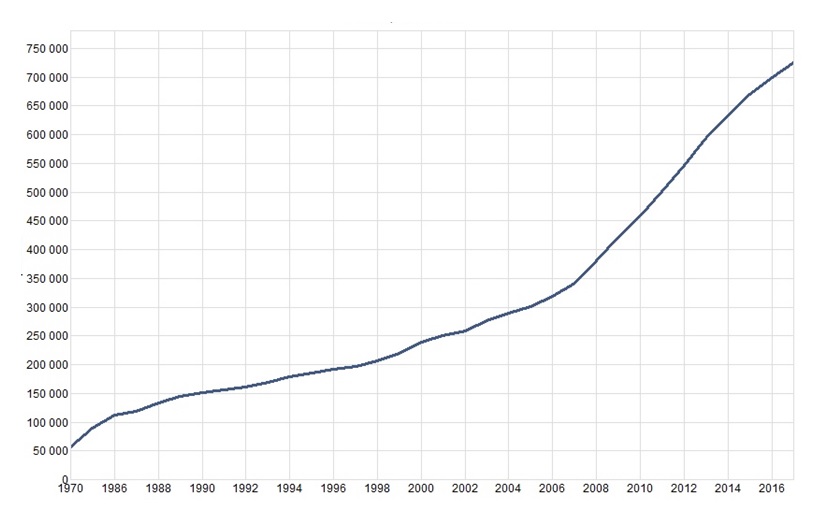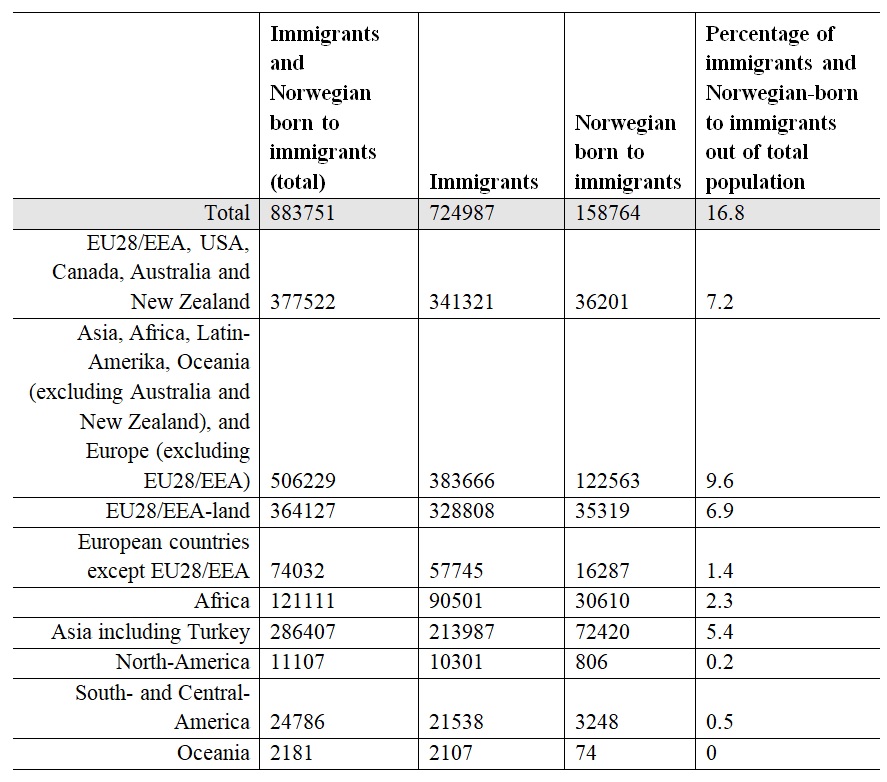Fostering Innovation Through Workplace Diversity

DOI reference: 10.1080/13673882.2018.00001002
By Marte C W Solheim
University of Stavanger Business School.
Marte C W Solheim investigates how diversity within the workplace effects the capacity for firms to innovate and the relationship between firm location and the risk of being locked into a “wolfpack” mindset.
Highlights:
- This piece discusses how different forms of diversity affect different types of innovation.
- It highlights how foreign workers can connect firms to international partners and international markets.
- It shows how a diverse workforce, in terms of differences in educational or life experience can lead to patenting, whilst a more similar workforce fosters process or product innovation.
- It is draws on findings from my PhD thesis, “Innovation, Space, and Diversity”.
Diversity challenging the wolf-pack syndrome
After working together for a while, people tend to become institutionalized and adopt similar ways of completing tasks. Such similarity is referred to as the wolf-pack syndrome, and it demonstrates a reflexive response to a task. This could make operations run more smoothly, but it could also risk resistance to change and variety in creative approaches. This might be challenged by bringing diverse knowledge into one’s work and actively reaching across existing organisational boundaries.
Wolf-pack syndrome occurs when a worker cannot approach a task differently from his or her pack of professional colleagues. As former Vice President of Human Resources at Apple, Kevin Sullivan, tellingly remarked, “When you are surrounded by sameness, you only get variations of the same”. People prefer to engage in relationships with others that they perceive to be similar to themselves and continue doing things in “the ways that it has always been done”. Humans pursue such relationships because they are comfortable and communication flows easily. When humans are exposed to new information and novel encounters these are put into cognitive classifications or “boxes” in order to understand this ‘new’. A person cannot be diverse alone, but can be so in relation to other people. People differ from one another in many ways, such as the place in which they were born and raised, their educational or industrial experiences, gender, sexual orientation, languages spoken, beliefs, religions, norms, and traditions. Based on some of these elements, people tend to classify each other as similar or dissimilar to themselves or to others, and this often leads to the creation of “in-groups” and “out-groups”. The in-group is a social unit of which an individual psychologically identifies themselves as a member. Contrastingly, the out-group is an entity with which one does not identify. Hence, people organise themselves and others into groups that are often dependent on some of these above-mentioned characteristics.
This practice has self-reinforcing effects, in which one prefers to work with people similar to oneself, and over time these colleagues become even more similar. Under these conditions, new ideas can be increasingly rare, as most issues will be met with similar solutions, attitudes, or perspectives as those encountered previously. Challenging these groups and “wolf pack” ways of thinking can boost conflict levels and increase communication costs, but challenging these groups and working across boundaries is often beneficial and can foster innovation.
Different experiences, different ideas
The key to increasing innovation capability could therefore be to introduce diversity in different ways; for example, by including people from different places or with diverse industrial backgrounds. In a recent study I carried out with Sverre J. Herstad on 2,942 Norwegian enterprises (Solheim and Herstad, 2017), we investigated how different types of diversity affect different types of innovation. We applied a unique data-set (made available from Statistics Norway) compiled by Linked Employer-Employee Data (LEED), which was merged with the Community Innovation Survey (CIS). We then considered employees’ educational and industrial experience profile in relation to various measures of innovation. Simply put, we determined whether employees had related or unrelated educational and industrial experience. Our results demonstrated a positive association between employees that had unrelated industrial backgrounds and the enterprise’s propensity to patent, i.e. applications for new innovations. We also found a positive association between people with related industrial experience and product and process innovations.
This suggests that people that share similar experiences know of similar working methods or frameworks and hence work well together. This could then lead to innovations, but they would not be revolutionary. According to Schumpeter, innovation refers to new combinations of already existing resources, based on a process of trial and error within firms that offers opportunities for organizations to learn. It has been argued that organizational learning can be divided into three aspects (Levitt and March, 1988): First, routines with trial and error being a key component of routinization; Secondly, firms’ history-dependent decisions; and Thirdly, target-oriented organizations.
Innovation is a social process, and therefore the concept of diversity in the workforce becomes relevant as it affects the perception of the problem, shakes up routines, and “fills the blanks”. When people differ in their knowledge and expertise, they might differ in their identification of the problem or what solutions would best fit that situation. Hence, people who are more similar are expected to perceive problems and find adequate solutions in ways that are more similar. Perhaps this is why we find that relatedness affects routines positively through being positively and statistically significantly associated with innovation processes and products and why we find that unrelatedness, representing a break from the history-dependence and bringing in different routines, shapes firms’ innovation capability and, henceforth, their ability to file a patent for something new.
Birthplace diversity affecting innovation
Extensive literature has investigated the effects of birthplace diversity on earnings, efficiency, and other economic performance indicators. Many believe that your birthplace affects more than just the language you speak, but also your personal heuristics and perspectives. Your environment shapes you, and people and places influence each other. Combining people with diverse backgrounds could lead to new approaches. However, the literature lacks studies that examine in greater depth what kind of mechanisms arise surrounding how birthplace diversity affects innovation.
Norway is becoming increasingly birthplace diverse (Figure 1 and Figure 2), and data from 2017 reveal that 16.8% of the population are immigrants or Norwegians born to immigrants (Table 1). In 1970, there were 57,041 immigrants in Norway, and over the last ten years, the number of immigrants has gone from 341,830 persons in 2007 to 724,987 persons today (Figure 2). Immigrants are present across the Norwegian regions, with a tendency to concentrate in the larger city regions (Figure 3).
Figure 1. Immigrants and Norwegian-born to immigrant parents, by country of origin from 1 January 2017

Despite this increased diversity, little research has been carried out demonstrating how this increased diversity could affect firm performance, innovation, and presence in international markets. In a recent study, myself and Rune Dahl Fitjar (Solheim and Fitjar, 2016) sought to use survey data covering about 500 Norwegian firms asking managers with whom and how they organize their innovation processes. The survey was carried out in 2013 and covered private sector firms across all of Norway’s regions. Our main findings suggested that firms that employed foreign workers collaborated with a broader range of international partners. We only witnessed this positive association when the managers reported having foreign workers with higher levels of educational attainment.
Figure 2. Graphic demonstrating the number of immigrants in Norway, starting from around 50.000 in 1970 until well over 700.000 in 2017. Source: Statistics Norway.

Figure 3. Map demonstrating the concentration of immigrants (immigrants only, not including Norwegians born to immigrants) across counties in Norway. Core regions are indicated. The numbers reported are persons. Total number of inhabitants in Norway is 5.258317 persons. Source: Statistics Norway. All data updated January 2017.

Our assumption is that this is because they were then in positions in which they could contribute to innovation processes and facilitate connections to international partners through their social and/or professional networks. This could also be justified because they have language skills that facilitate and ease this interaction. We further find a positive association between firms that collaborate with international partners and new product innovations, particularly to radical product innovations within the world market. In addition, process innovations that were new to the industry were positively associated with collaboration with international partners. One potential explanation is that international partners bring in valuable new knowledge and information to their firms.
Table 1. Immigrants and Norwegian-born to immigrants: summary statistics

Diversity is also beneficial in the periphery
Most research on diversity has been carried out regardless of where firms are located. Firms in city regions tend to be more diverse in terms of attracting foreign-born workers and in their industrial composition. The ability to compete internationally is one way to create a competitive advantage, and some research has demonstrated that diaspora linkages and foreign-born workers could contribute to launching goods and services in international markets. However, studies are needed that more carefully consider firm location. In this respect, two questions are paramount: Are firms in peripheral regions capable of being present in the global market? and, can diversity help them become more able to do so?
In a recent study, I used linked employer-employee data merged with the Community Innovation Survey (CIS) (made available by Statistics Norway), to determine whether there was a positive association between launching goods and services in international markets and foreign workers and collaboration with international partners. The objective was to see whether this applies similarly for firms in peripheral, intermediate, and core regions (Solheim, 2016).
The results published in Regional Studies, Regional Science (Solheim, 2016), demonstrate that firms in peripheral regions take part in global processes and that this is being facilitated through collaboration with international partners. Whilst firms in core regions tend to collaborate with a more diverse range of international partners, the firms in peripheral regions seem to collaborate with international partners that are closer to them geographically, perhaps because they perceive these partners also to be cognitively proximate. The results demonstrate a positive association with firms located in peripheral regions and collaboration with Nordic partners in relation to being present in international markets. An interesting finding is also that regional collaboration seems to be negatively associated with firms’ launching goods and services onto international markets, which further highlights the importance of obtaining international input.
Related to this is how boundary spanning is a key ingredient in creating a competitive advantage, which can also refer to extending across disciplines. The transfer of knowledge across boundaries fosters a shared language, and that is why one’s level of cognitive proximity is crucial in order to understand what is being transmitted. Too little cognitive proximity leads to misunderstanding, and too much cognitive proximity leads to a lack of novelty (Boschma, 2005).
Working across boundaries
Hence, a possible solution is a common knowledge base with diverse but complementary capabilities (Boschma, 2005). Such a knowledge base lies at the core of innovation. Fitjar et al. (2016) discuss this in their paper entitled, “Not too close, not too far: Testing the Goldilocks principle of ‘optimal’ distance in innovation networks,” concerning optimal partners for innovation. The Goldilocks principle refers to the fairytale of “Goldilocks”, in which the eponymous heroine finds a house in the woods and walks in to find it empty. On the kitchen table are three portions of porridge, she sits down at the table and soon realises that the first portion is too cold, the second portion is too hot, and the last one is just perfect. She walks around the house and continues with this procedure, testing the chairs, the bed, and so on, until she discovers one that is just right. This is the idea behind identifying the ideal collaboration partner, which Fitjar et al. (2016) identify as the one at “the right distance” – not too close and not too far. Partners must share some common knowledge and find common ground on which to start the discussion. This idea of distance is valid in organisations and in interactions between people too: you need a shared platform from which to start.
The paper “Foreign workers and international partners as channels to international markets in core, intermediate and peripheral regions” (Solheim, 2016) investigates the role of foreign workers in association to firms launching goods and/or services on international markets. Following the logic of shared platform and proximity mentioned above, foreign workers inherit skills that could prove beneficial to launch goods and services in the international markets, given that foreign workers often remain in contact with their native networks, and thus can increase the trust among these relations. Foreign workers also speak different languages and can deliver juridical, logistical, and cultural knowledge that could prove beneficial in entering a new market. The results demonstrate a positive association between foreign workers from EU-15 countries, and launching goods and/or services onto international markets. For the other foreign workers, the results are mixed.
Sometimes similarity is what you need
Although there are studies that report the positive effect of diversity, many find no evidence of diversity being beneficial for increasing innovation and productivity, and some even report negative effects.
This ambiguity occurs because diversity and performance indicators are measured in different ways. Extant studies have been carried out from the perspective of different academic disciplines and in different contexts. Some studies focus on diversity and innovation within firms and some focus on the regional geographical scale in which firms operate. Studies at the firm level have also differed, with for example, several past contributions studying top management teams to the exclusion of the whole organisation. Thus to better understand the role played by diversity, more studies are needed that are more transparent in their conceptualisations of diversity and the generalisability of their results.
References
About Marte

Marte C W Solheim is a post-doctoral researcher at the Centre for Innovation Research, University of Stavanger Business School in Norway. Her key research interests include studying various forms of diversity (particularly birthplace diversity) and innovation, combining insights from organisational theory, economic geography and innovation studies.
Research-gate profile